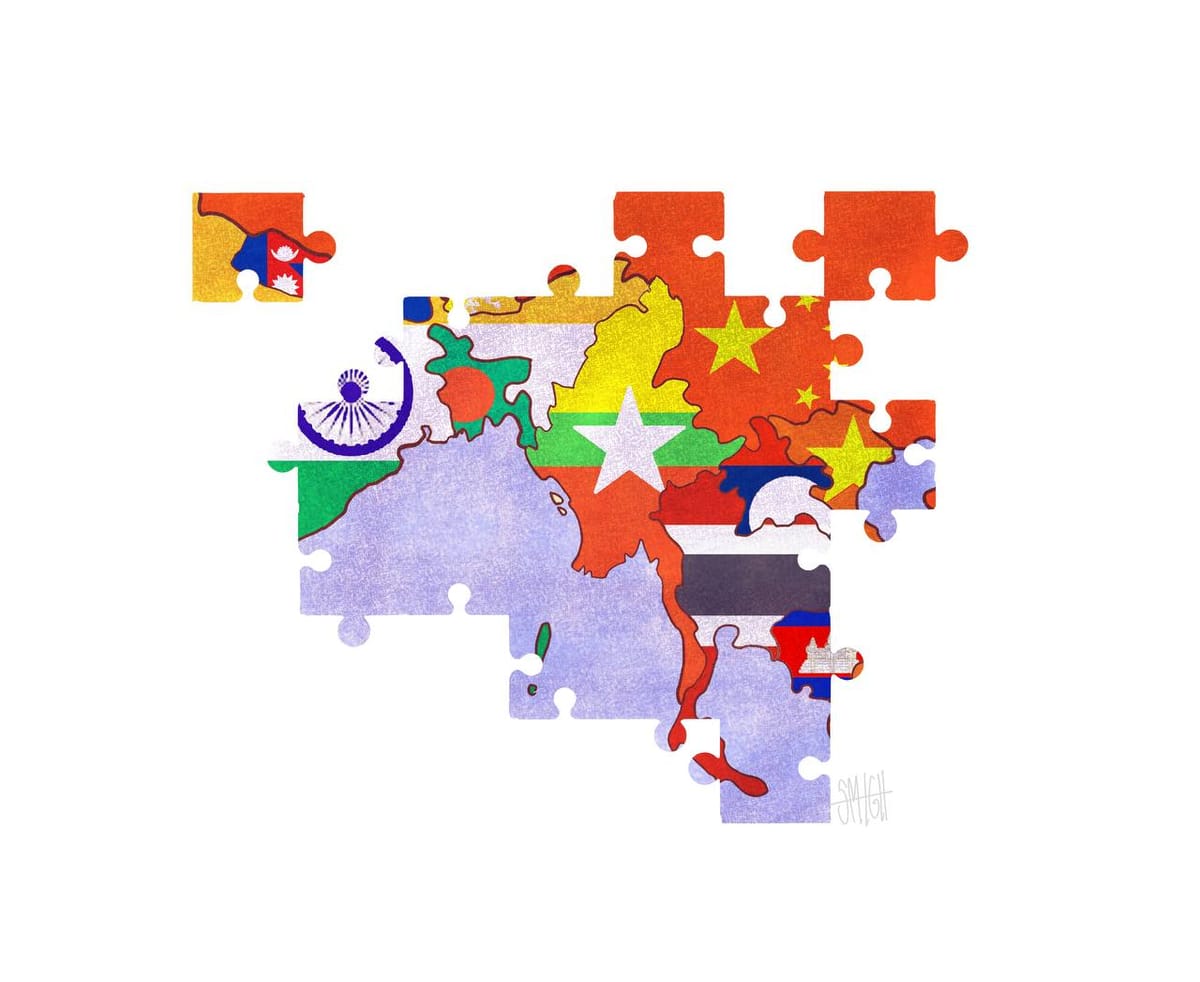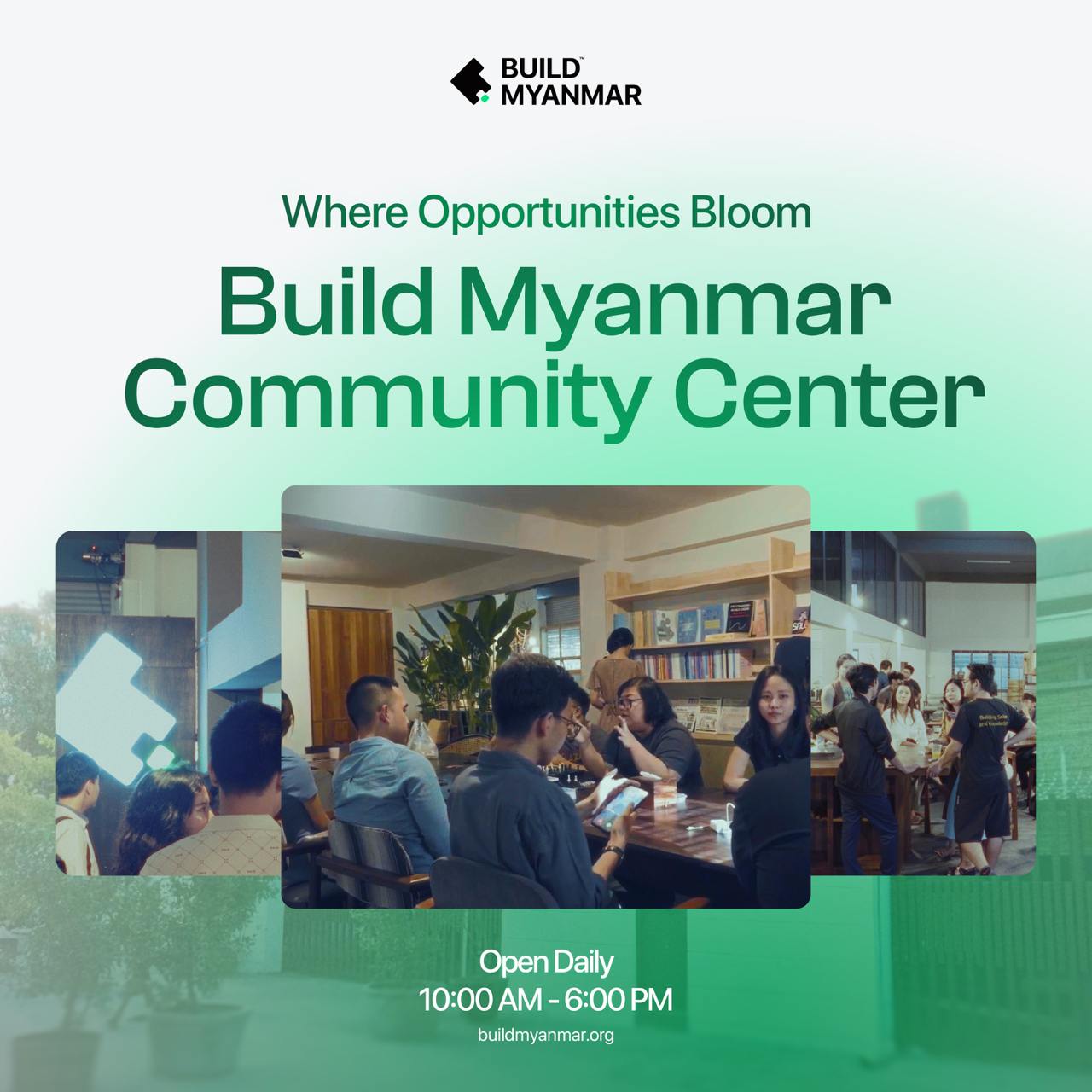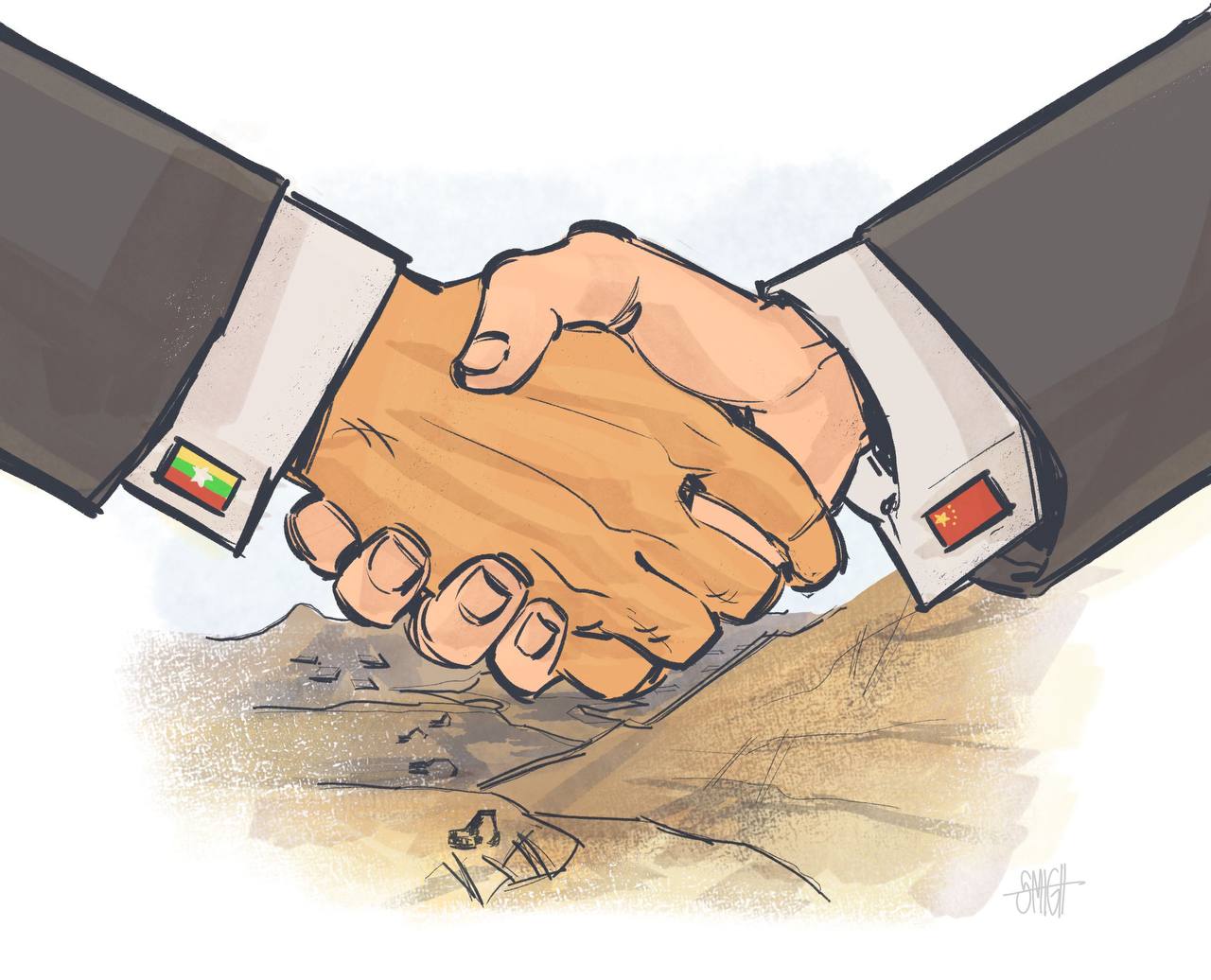
Myanmar occupies a strategically important location in Southeast Asia. With access to the sea and abundant natural resources, the country shares borders with five neighboring nations. Bangladesh and India lie to the west and northwest, China to the northeast, and Laos and Thailand to the east and southeast.
Among these five nations, China and India are the world's most populous countries, with China being a global superpower. Thailand is a developing nation, while Myanmar-Laos relations remain relatively minimal. However, Myanmar-Bangladesh relations continue to face unresolved issues requiring ongoing negotiations and dialogue.
Myanmar-China Relations
The relationship between Myanmar and China spans thousands of years, encompassing religious, literary, and cultural exchanges. When the Communist government and Kuomintang (White Chinese) forces clashed in China in 1949, the defeated Kuomintang fled into Myanmar, prompting Myanmar to raise the issue with the United Nations. When diplomatic solutions proved ineffective, Myanmar had to resolve the situation through military action. When Mao Zedong declared the new Chinese state in 1949, Myanmar was among the first non-communist countries to recognize it. Myanmar also supported China's entry into the United Nations.
Official diplomatic relations between Myanmar and China began on June 8, 1950.
During the early independence period under the AFPFL government, Myanmar maintained balanced relations with China. Border issues between the two countries were also addressed. During Myanmar's extended military rule, China acted as Myanmar's defender on the UN stage. In return, China gained access to various business operations within Myanmar.
After Myanmar's independence, China provided substantial support to the Communist Party of Burma during the civil war. China's influence and involvement are also evident among ethnic armed groups in eastern and northern Myanmar, particularly with northern ethnic armed organizations that maintain strong ties with China. This makes China's role crucial in Myanmar's peace process. The coordinated ceasefire announcements by ethnic armed groups along the Myanmar-China border during Chinese Communist Party Politburo meetings demonstrate this influence.

Where Opportunities Bloom
A place where creativity, learning, and connection come together. The Build Myanmar Community Center is the ultimate solution for youth seeking inspiration and opportunity.
This innovative center offers:
- Fully-equipped spaces with high-speed internet
- Flexible co-working areas for collaboration
- Networking opportunities
- Diverse workshops led by experts from various fields
- A comprehensive library for knowledge seekers
- Maker spaces to fuel creativity and innovation
Interested in transforming your potential? Explore the link below and discover a world of possibilities.
Throughout history, China has prioritized government-to-government relations with Myanmar while maintaining minimal people-to-people connections. Chinese economic expansion, interference in border stability, and internal affairs have led to negative perceptions among Myanmar's people.
Nevertheless, China remains Myanmar's largest investor. Myanmar-China border trade amounts to billions of dollars annually, though trade balance typically favors China. China has also heavily invested in natural resource extraction in northern Myanmar. Conflicts have arisen, and many issues remain unresolved due to Chinese businesses aggressively pursuing tissue banana plantations, dam construction, casino operations, and rare earth mining in Myanmar, often causing environmental damage.
Some notable Chinese projects in Myanmar include the Yangon New City Project, online casino operations and human trafficking issues at Shwe Kokko, the Letpadaung Copper Mine in central Myanmar, the Myitsone Dam in the north, the Belt and Road Initiative, the China-Myanmar Economic Corridor (CMEC), the China-Myanmar Oil and Gas Pipeline, the Kyaukphyu Deep Sea Port, and the Muse-Mandalay Railway.
Following the 2021 military takeover, China has expressed concerns about its interests in Myanmar.
Myanmar-Thailand Relations
Myanmar and Thailand have a history of mutual invasions and conflicts dating back to ancient kingdoms. The last military confrontation between the two countries occurred in 2001 over the disputed O-7 hill near Tachilek. There have been no military disputes since then.
Diplomatic relations between Myanmar and Thailand began on August 24, 1948. While Myanmar is known for extended periods of military rule, Thailand has experienced numerous coups.
During periods of military rule in Myanmar, ethnic armed groups often seek refuge along the Thai border, establishing liberated areas. Local people also flee to refugee camps in Thailand. Throughout history, Myanmar politicians, military generals, and national leaders have sought refuge in Thailand.
Economically, Myanmar signed a border trade agreement with Thailand on March 17, 1996. Bilateral trade amounts to billions of dollars. Thailand is a major buyer of natural gas from Myanmar, accounting for 15% of Thailand's natural gas imports. In terms of investment, Thailand became the third-largest investor in Myanmar by 2023, two years after the military takeover. Thailand has significant investments in Myanmar's Yadana gas project and the Thilawa Special Economic Zone. Thailand also provided electricity to the Golden Triangle casino operations at the Thai-Myanmar border, though this was recently suspended due to Chinese pressure.
Following the 2021 military takeover, young people from Myanmar increasingly sought work in Thailand due to domestic job scarcity. The number of Myanmar people settling in Thailand has also grown. Mae Sot, on the Thai side of the border, has become home to many Myanmar people, as has Chiang Mai. These cities have become operational grounds for intelligence agencies from both countries.
After the 2021 military takeover in Myanmar and the emergence of the National Unity Government parallel to the State Administration Council (SAC), Thailand maintains official diplomatic relations with the SAC.
Thailand supports ASEAN's Five-Point Consensus on Myanmar through ASEAN channels while working to maintain its traditionally good relations with Myanmar's successive military governments.
Myanmar-Laos Relations
Diplomatic relations between Myanmar and Laos were established relatively late, in 1995, primarily due to Laos' internal situation. The two countries maintain embassies in Yangon and Vientiane respectively.
Historically, the Golden Triangle region, where Thailand, Myanmar, and Laos meet, was infamous as the world's largest opium-growing area.
Both countries participate in the Mekong River Commission, collaborating on water resource management.
Economic relations between the two countries are conducted through the border trade station in Tachilek, though trade volume is minimal compared to that with Thailand or China. There is no significant investment between the countries. Discussions continue regarding tourism development, investment growth, and labor issues.
Myanmar-Bangladesh Relations
Myanmar-Bangladesh relations remain complicated, particularly regarding migrant issues, with ongoing disagreements and difficult negotiations. Maritime boundary disputes arose in 2012. Non-ethnic armed terrorist groups operate along the border, and cross-border crime remains an issue. Both countries continue to work on eliminating drug trafficking, addressing illegal migration, handling displaced persons, and their resettlement.
Economically, Myanmar and Bangladesh maintain small-scale trade relations. The volume exceeds Myanmar-Laos trade but is significantly less than Myanmar's trade with Thailand or China. Trade with Bangladesh primarily occurs through Rakhine State.
Myanmar-India Relations
Historically, Myanmar and India share the experience of British colonization, with Myanmar being administered as part of India under British rule. This led to close cooperation between independence movement leaders and mutual assistance.
Diplomatic relations between Myanmar and India began on January 4, 1948. Myanmar's first Prime Minister U Nu and Prime Minister Nehru maintained close relations, both being leaders in the Non-Aligned Movement. When civil war erupted in newly independent Myanmar, U Nu received military assistance from Nehru.
After India's independence, both countries conducted joint operations against Indian separatist movements along their shared border. Despite issues with armed groups along the border, they managed to resolve conflicts through negotiation.
Mahatma Gandhi visited Myanmar three times, while General Ne Win made eleven official visits to India. However, when Ne Win seized power in 1962 and implemented socialism, he nationalized properties owned by Indians in Myanmar, causing relations to cool.
The countries maintain military cooperation and defense collaboration. In 2020, Myanmar's navy acquired its first submarine from India.
Economically and strategically, Myanmar is crucial for India's Look East Policy as a gateway to Southeast Asia. In 2008, both governments signed the Kaladan Multi-Modal Transit Transport Project, supported by India. The Sittwe-Kaladan Port Project, part of this initiative, began operations in May 2023. Border trade is significant, exceeding one billion US dollars. Additionally, they are jointly developing the India-Myanmar-Thailand Trilateral Highway.
Following Myanmar's 2021 military takeover, India has maintained a notably neutral stance, neither openly criticizing nor showing clear support for any side, instead maintaining existing relations.
Conclusion
Myanmar's strategic location in Asia creates complex relationships with its neighbors. The country maintains close political, economic, and military procurement ties with China, Thailand, and India, with particularly strong connections to China. The relationship with China is crucial for Myanmar's peace process and armed conflicts. Meanwhile, relations with Bangladesh require trust-building due to refugee issues. The future of Myanmar's diplomatic relations with its neighbors, balanced against national interests, remains an intriguing subject for observation.
By Han Thit Eain (Y3A)
Read More:
 Build Myanmar - MediaY3A
Build Myanmar - MediaY3A
 Build Myanmar - MediaY3A
Build Myanmar - MediaY3A
Build Myanmar-Media : Insights | Empowering Myanmar Youth, Culture, and Innovation
Build Myanmar-Media Insights brings you in-depth articles that cover the intersection of Myanmar’s rich culture, youth empowerment, and the latest developments in technology and business.
Sign up for Build Myanmar - Media
Myanmar's leading Media Brand focusing on rebuilding Myanmar. We cover emerging tech, youth development and market insights.
No spam. Unsubscribe anytime.
Sign up now to get the latest insights directly to your mailbox from the Myanmar's No.1 Tech and Business media source.
📅 New content every week, featuring stories that connect Myanmar’s heritage with its future.
📰 Explore more:
- Website: https://www.buildmyanmarmedia.com/
- Facebook: https://www.facebook.com/buildmyanmar
- YouTube: https://youtube.com/@buildmyanmarmedia
- Telegram: https://t.me/+6_0G6CLwrwMwZTIx
- Inquiry: info@buildmyanmar.org
#BuildMyanmarNews #DailyNewsMyanmar #MyanmarUpdates #MyanmarNews #BuildMyanmarMedia #Myanmarliterature #myanmararticle #Updates #Insights #Media
